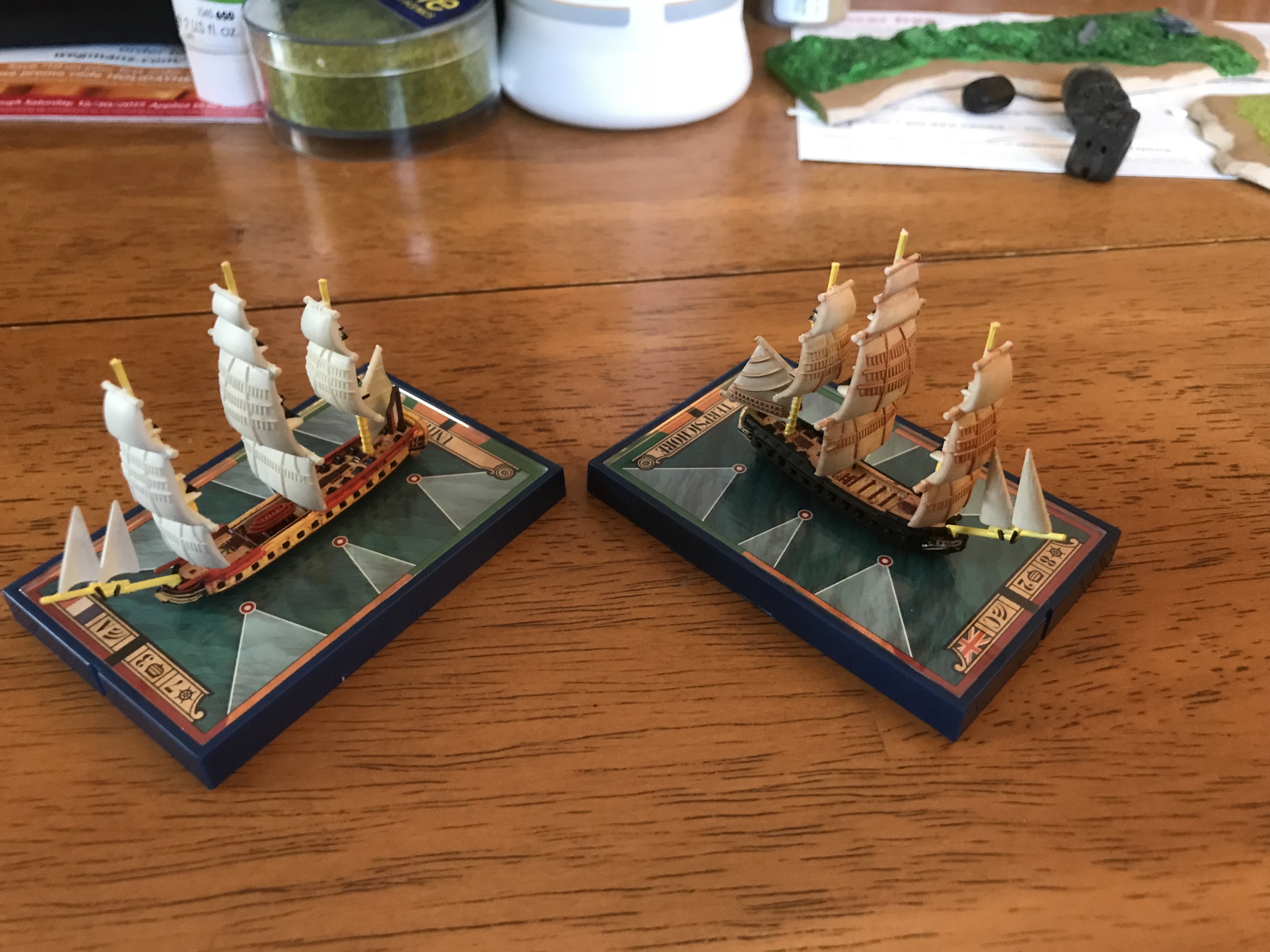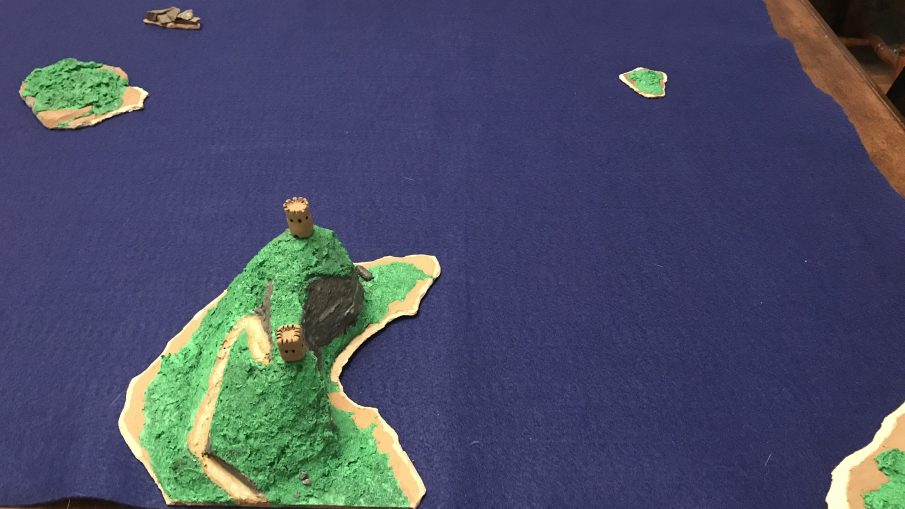Tabletop •
I recently got an itch to play Sails of Glory, a game which wonderfully illustrates the joys which games, especially historical games, offer outside of the game itself. Sails of Glory puts each player in charge of one or two warships from the age of sail (late 1700s/early 1800s). Turns out, there are an embarrassing array of ways to commit to it, and it was with an eye toward justifying myself that I thought of writing an article on the topic.
I’m not terrifically familiar with the era, but I fondly recall Stephen Budiansky’s book about the naval War of 1812, and enjoyed the movie Master and Commander: The Far Side of the World enough that I later read the series on which it’s based. There was a pretty decent recent Dutch movie, Admiral, as well. So you might say my preparation for the game began years ago, and was only renewed after I decided to get the game and deliberately evoke the mood by watching Master and Commander again and rereading the series. That long preparation led me to enough of an awareness of the tactical questions of the setting to be able to appreciate rules intended to replicate them.
That was really what sold me on the game. Well, that and an upstate New York winter which had me pining for the Caribbean Sea. But, before I bought the game, I downloaded and read the rules, and was impressed at how the game seems to attempt to capture what seems to have been salient in actual ship-to-ship battles. The wind is as important as it seems like it ought to be, with the force to windward having far more discretion than that to leeward about when to engage (though, in a compromise with the interests of players, the limited size of the playing surface makes declined engagements or protracted chases undesirable or impossible). In addition to altering sail and attacking, you can have your crew repair the ship mid-battle, which I have for some reason always found fascinating. That is, you can have them do so as long as they’re alive–the several kinds of damage include what we might delicately call “nondiscretionary reductions in crew strength”.

There are also solo rules, which is great because I’m not terribly sociable and my kids are still a little young for the complexity of the full game. They are most sensible for simulating attacks on static fortifications, but Ares Games is between printings of the shore batteries expansion, and they’re not to be found. Fortunately, I was excited to do some modeling for a vibrantly-colored and three-dimensional playing surface, so I bought some blue felt and made some islands. This consisted mostly of whittling away at some spare hunks of eucaboard to create moderately plausible edges, and then topping them with a mixture of wood glue and sawdust. The largest island also includes some styrofoam (which I had mistakenly thought entirely sealed in joint compound before I spray-painted it. Don’t spray-paint styrofoam), grout, and some Sculpey clay towers. Painted up, they look just a touch cartoonish, which seemed the best alternative to a realism which would have required that I figure out some way to make tiny palm trees which wouldn’t be crushed in any plausible storage. The miniature ships come pre-painted, but even a painter as untalented as myself can make the detail on the sails pop with a light wash.
With these preparations complete and the rhythm-heavy score to Master and Commander playing, I started my first solo explorations, first just testing the maneuvers, and then proceeding to attack my custom fortifications. I quickly felt like poor Stephen Maturin, astonished at how completely the wind commands the engagement, and how very helpful it is to have a clear grasp of how your ship handles and what the consequences of its maneuvers may be. Moreover, the narrow field and not overly-generous range of a broadside caught me aback (“taken aback” being one of a surprisingly large number of nautical terms which persist in modern English, metaphors to once-familiar situations now stripped of the manifold associations of their original context), and only about one pass in three left my frigate able to bring its great guns to bear at all. The experience left me persuaded that such solo engagements are satisfactory for learning the game and the capabilities of its ships, but that the yomi element with a similarly limited human opponent would be far more enjoyable. Fortunately, some enterprising fans of the game have worked on ship AIs, much like those which exist for X-Wing (though without the marvelous app support, it being a much smaller community), and I look forward to exploring them for weaknesses.

I still have some ways I’d like to enhance my experience. With my first expansion ship on the way, I’d like to consider storage options. While I don’t quite want to go all the way to upgrading my ships with superior rigging or thorough repaints, even painting just the masts and yards seems to make a striking difference with minimal work. I’m also interested in replacing the game’s damage chit pull bags with random choice from spreadsheets–while I understand the desire to help probability along by removing used chits, it offends my sense of fairness for a fire in one ship to reduce the chances of a fire in another. In doing all of this, I am reminded of Reiner Knizia’s dictum “Remember: When playing a game, the goal is to win, but it is the goal that is important, not the winning…”. I can happily chip away at a large volume of tasks I genuinely enjoy when they help me commune with a game, even if I rarely play. Indeed, so consuming has been my reading on the topic that I started writing this article when I had just started the Aubrey/Maturin series, and I’m on book fifteen now.



The game looks great and I’ve been tempted to buy it off my game store’s shelf, but I think I’m burned out on miniature games from X-Wing. There is just something a bit sloppy about all the movement and range checks and everything. I’m also a bit tired of all the build min/maxing. I know that has nothing to do with Sails of Glory, but it’s what kept me from pulling the trigger.
On a slightly unrelated note, does anyone remember that Pirates of the Spanish Main game? The game wasn’t very good from what I remember, but I thought those random packs of ships were awesome!
Oh yeah, I bought a ton of those little plastic ships and had them all over my cubicle back in the day.
I don’t know how others sustain the will to paint and model. Did I hit the Warhammer too hard back in the day? Not hard enough? Perhaps I’m just lazy.
Age of Sail combat does have some magic to it though. I bought 1805: Sea of Glory because it was cheap, and found a great strategy game, admittedly one that requires a lot of processes and does run long. Weather rolls, search rolls, chit pulls, command rolls, combat rolls, Fate rolls, more chit pulls; it all takes a wee while to work out, but the different hidden victory point objectives, hidden unit composition, variable turn length, and the battles where the weather gauge is of the utmost importance at least keep it interesting if not riveting. My one full length campaign game went 20+ hours, over three or four (more like six or so) sessions. Both new players, but still: hefty. The map was also wounded (perhaps not badly) in the ongoing RGB-CMYK War.
I do love it, I just wish I could play it more.
I think that after I broke one of the ships in PotSM while trying to assemble it, my ardor cooled fast. Neat idea, though.
I agree with you about the sloppiness of movement. It’s funny—I don’t like the basic mechanic, but everything else around it appeals to me, so I have a decent X-Wing collection, enough Star Trek: Attack Wing to satisfy me, Sails of Glory, and even Tail Feathers.
Sorry to derail this post so much, but can I get your brief thoughts on Tail Feathers? I have all the Mice & Mystics stuff and feel like it might be a fun game to play with my son some day.
It’s a little too complicated for the purpose. There’s a ton I love about the game, particularly the abstracted skirmishes on the ground which let you flexibly add objectives to the board, thereby elevating the game above simple dogfighting. But, where Mice and Mystics could be presented to children very simply, because it was cooperative and the adult could muck about with anything funky, Tail Feathers is inherently more complicated and also competitive, so that doesn’t really work.
My daughter was over the moon when she saw the game, and begged me to get it because she really wanted to play it. Faced with the prospect of actually doing so, she couldn’t handle it and bailed. So my experience with it has been terribly disappointing, in ways which do reflect on the game somewhat, but I still think it’s very cool and advances the flightpath-style mini-genre in ways I’d love to see other games pick up. I’d love to see an X-Wing RPG-lite which uses something like this system for interactions with ground battles (that might be graftable onto HotAC; indeed, I wouldn’t be surprised, with all the fan-made content, if there’s already something like this available).
The short version of my thoughts on Tail Feathers: it’s why I am so attracted to Stuffed Fables and also why I haven’t bought it.